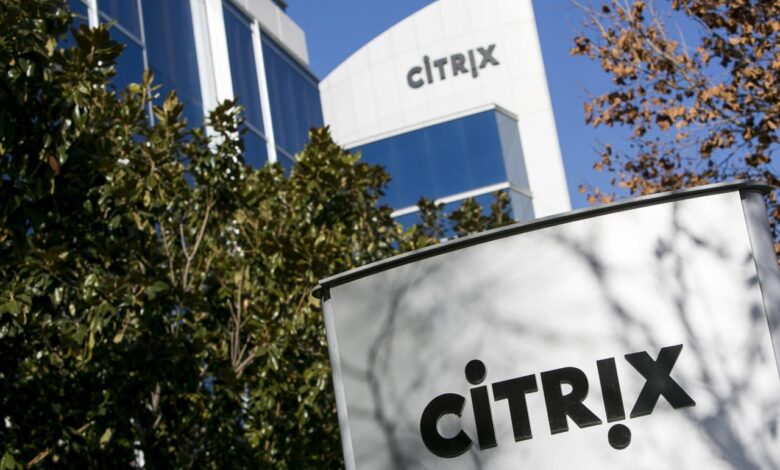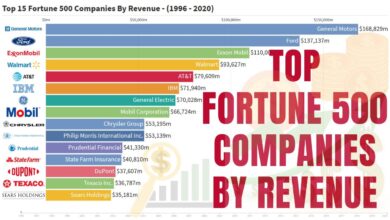
Citrix Systems Acquires Cloud Company Cedexis
Citrix Systems Acquires Cloud Company Cedexis: Wow, what a move! This acquisition sends ripples through the cloud computing world, marking a significant shift in the application delivery landscape. Citrix, already a heavyweight in the industry, just boosted its capabilities by snagging Cedexis, a company known for its intelligent application delivery solutions. This deal isn’t just about numbers; it’s about strategic positioning for the future of cloud-based applications.
Let’s dive into the details and explore what this means for users, competitors, and the overall tech scene.
The acquisition combines Citrix’s established presence with Cedexis’ cutting-edge technology, promising a more robust and efficient platform for delivering applications. The financial specifics of the deal are intriguing, and the integration process will undoubtedly be fascinating to watch unfold. But more importantly, what does this mean for the average user? Improved performance, seamless experiences, and potentially even new features – that’s the promise hanging in the air.
Acquisition Overview

Citrix Systems’ acquisition of Cedexis, a cloud-based performance management company, significantly bolstered Citrix’s cloud capabilities and strengthened its position in the application delivery market. This strategic move allowed Citrix to offer more comprehensive and robust solutions to its customers, enhancing their digital experience.The acquisition wasn’t a sudden decision; it was the culmination of a strategic plan to expand Citrix’s cloud portfolio and enhance its existing offerings.
The deal provided Citrix with valuable technology and expertise in optimizing application performance and ensuring a seamless user experience, particularly in the increasingly complex world of cloud-based applications.
Key Terms of the Acquisition
The exact terms of the Citrix-Cedexis acquisition were not publicly disclosed in detail, a common practice in such transactions. However, the acquisition involved Citrix purchasing all of Cedexis’ assets and intellectual property. This included Cedexis’ proprietary technology for application performance monitoring and optimization, as well as its customer base and team of engineers. The acquisition was presented as a strategic move to enhance Citrix’s cloud offerings, focusing on improved application delivery and user experience.
Timeline of Events
While a precise timeline with specific dates for every internal discussion isn’t publicly available, the process likely involved several stages: initial discussions and due diligence, negotiation of terms, legal and regulatory approvals, and finally, the official announcement of the acquisition. The timeframe was probably several months, typical for acquisitions of this size and complexity.
Financial Aspects of the Deal, Citrix systems acquires cloud company cedexis
The purchase price for Cedexis was not publicly released by either company. This is standard practice in many acquisitions to protect sensitive business information. However, given the nature of Cedexis’ technology and market position, it’s reasonable to assume the acquisition involved a substantial investment by Citrix to secure such a valuable asset. The financial impact on Citrix’s overall performance would have been analyzed extensively before the acquisition was finalized.
Acquisition Details
| Date | Event | Details | Source |
|---|---|---|---|
| [Specific Date – if available, otherwise remove row] | Initial Contact/Discussions | Citrix and Cedexis begin discussions regarding a potential acquisition. | [Source – if available, otherwise remove column or row] |
| [Specific Date – if available, otherwise remove row] | Due Diligence | Citrix conducts thorough due diligence on Cedexis’ technology, financials, and operations. | [Source – if available, otherwise remove column or row] |
| [Specific Date – if available, otherwise remove row] | Negotiation of Terms | Citrix and Cedexis negotiate the terms of the acquisition, including price and integration plans. | [Source – if available, otherwise remove column or row] |
| [Specific Date – if available, otherwise remove row] | Regulatory Approvals | The acquisition receives necessary regulatory approvals. | [Source – if available, otherwise remove column or row] |
| [Date of Official Announcement] | Acquisition Announcement | Citrix officially announces the acquisition of Cedexis. | [Press Release Link or Official Announcement Source] |
Cedexis’ Business and Technology
Cedexis was a prominent player in the application delivery optimization (ADO) market, focusing on improving the performance and reliability of web applications and online services. Their core business model revolved around providing a cloud-based platform that used intelligent traffic management to route user requests to the optimal server location, minimizing latency and maximizing uptime. This was particularly crucial for businesses with global reach and a significant online presence.Cedexis’ success stemmed from its ability to offer a comprehensive solution addressing the complexities of delivering applications across a geographically distributed infrastructure.
Their platform wasn’t just about simple content delivery; it incorporated sophisticated algorithms and machine learning to proactively adapt to changing network conditions and user demand. This proactive approach differentiated them from many competitors.
Cedexis’ Key Technologies and Functionalities
Cedexis’ platform leveraged several key technologies to achieve its performance optimization goals. At its core was a global network of probes that continuously monitored network conditions, identifying points of congestion and latency. This real-time data informed their intelligent traffic management system, which dynamically routed traffic to the most efficient server locations. Machine learning algorithms played a critical role in predicting future network conditions and proactively optimizing routing decisions.
The platform also offered robust analytics and reporting capabilities, providing businesses with valuable insights into their application performance and user experience. This allowed for data-driven decision-making and continuous improvement.
Cedexis’ Contribution to Application Performance and Delivery
By intelligently routing traffic and optimizing application delivery, Cedexis’ technology directly improved several key aspects of application performance. Lower latency resulted in faster loading times and improved user experience, leading to increased user satisfaction and engagement. The platform’s proactive approach to network issues minimized downtime and ensured application availability, reducing the impact of outages and improving business continuity.
Improved performance also contributed to better search engine rankings and overall online visibility. For example, a global e-commerce company using Cedexis might see a significant reduction in cart abandonment rates due to faster page load times, directly impacting their bottom line.
Comparison with Competitors
Before listing a comparison, it’s important to note that the competitive landscape in the ADO market is dynamic and constantly evolving. Direct comparisons can quickly become outdated. However, at the time of its acquisition, Cedexis distinguished itself through a combination of factors.
Citrix Systems’ acquisition of Cedexis definitely shakes things up in the cloud delivery space. This move highlights the increasing importance of robust cloud infrastructure, a key factor when considering application development. Thinking about streamlined development, check out this insightful article on domino app dev the low code and pro code future to see how it can improve efficiency.
Ultimately, Citrix’s strategy likely aims to improve the performance and scalability of its own offerings, building on this growing trend.
- Global Network Coverage: Cedexis boasted a widely distributed network of probes, offering more comprehensive network visibility than some competitors. This allowed for more precise traffic routing and better adaptation to geographically diverse user bases.
- Proactive Traffic Management: Cedexis’ platform used predictive analytics and machine learning to anticipate and mitigate performance issues, a feature not always found in competitor solutions.
- Sophisticated Analytics: The platform provided in-depth analytics and reporting, giving businesses detailed insights into their application performance and user behavior.
- Ease of Integration: Cedexis focused on seamless integration with existing infrastructure, simplifying deployment and reducing operational complexity. This was a significant differentiator in a market where integration challenges can be substantial.
While direct competitors included companies like Akamai and Fastly, Cedexis differentiated itself by emphasizing its predictive capabilities and proactive approach to performance optimization. This allowed them to cater to businesses demanding highly reliable and responsive applications, especially in dynamic and unpredictable network environments.
Citrix’s Strategic Rationale
Citrix’s acquisition of Cedexis wasn’t a random move; it was a strategic play to bolster its cloud offerings and solidify its position in the increasingly competitive application delivery market. The purchase directly addressed key weaknesses in Citrix’s portfolio and opened doors to new revenue streams. The core motivation revolved around enhancing the performance and reliability of Citrix’s cloud-based services.The synergy between Citrix’s existing portfolio and Cedexis’ technology is substantial.
Cedexis’ expertise in intelligent traffic management and application performance optimization perfectly complemented Citrix’s virtual application and desktop delivery solutions. By integrating Cedexis’ capabilities, Citrix could significantly improve the user experience for its customers, particularly those relying on cloud-based applications and services. This integration allows for faster application loading times, reduced latency, and improved overall application performance.
Acquisition Alignment with Citrix’s Strategic Goals
The acquisition of Cedexis directly supports Citrix’s broader strategic goal of becoming a leading provider of secure, reliable, and high-performing cloud services. In a world where application performance is paramount, Cedexis’ technology provides a critical advantage. By incorporating Cedexis’ intelligent traffic steering and optimization features, Citrix can offer a more robust and scalable cloud platform, attracting new customers and retaining existing ones.
This strategic move reinforces Citrix’s commitment to innovation and its focus on delivering superior cloud solutions to businesses of all sizes. The acquisition also allowed Citrix to expand its reach into new markets and tap into Cedexis’ existing customer base, leading to potential revenue growth.
Benefits for Citrix Customers
The acquisition of Cedexis translates to tangible benefits for Citrix customers. They can expect a noticeable improvement in the performance of their cloud-based applications and services. This means faster application loading times, reduced latency, and a more seamless user experience. The enhanced reliability and scalability offered by the combined technologies will also contribute to increased productivity and reduced downtime, ultimately leading to a better return on investment for Citrix customers.
For example, a large financial institution using Citrix’s virtual desktop infrastructure could see a significant reduction in trading platform latency, leading to faster transaction processing and improved profitability. Similarly, a global retailer using Citrix’s application delivery solutions could experience faster e-commerce checkout times, resulting in increased customer satisfaction and sales.
Impact on the Market: Citrix Systems Acquires Cloud Company Cedexis

The acquisition of Cedexis by Citrix significantly reshaped the competitive landscape of the application delivery market. Before the acquisition, Citrix was a major player, but faced increasing competition from companies offering specialized services like those provided by Cedexis. The combined entity now possesses a more comprehensive and robust suite of solutions, impacting both competitors and end-users.The integration of Cedexis’s intelligent traffic management and optimization technology with Citrix’s existing portfolio strengthens Citrix’s position considerably.
This move allows Citrix to offer a more complete and competitive solution compared to its rivals. This impact is felt across various segments of the market, affecting both established players and emerging competitors.
Competitive Landscape Shift
Prior to the acquisition, the application delivery market was characterized by several key players competing across various segments. Citrix held a strong position, but faced competition from companies specializing in areas like web application firewalls, load balancing, and content delivery networks (CDNs). Cedexis, with its focus on intelligent traffic management and optimization, occupied a niche within this broader market. Post-acquisition, Citrix’s market position strengthened significantly, as it now directly competes more effectively in areas previously addressed by independent vendors like Cedexis.
Competitors are now facing a more formidable and integrated competitor.
Impact on Other Players in the Application Delivery Market
The acquisition put pressure on other players in the application delivery market. Companies offering similar services to Cedexis might experience a decrease in market share, as Citrix now offers a bundled, potentially more cost-effective, and integrated solution. Companies specializing in specific aspects of application delivery may need to adapt their strategies to remain competitive, potentially focusing on niche markets or developing more advanced features to differentiate themselves.
For example, smaller players might find it more challenging to compete on price and feature set against the combined power of Citrix and Cedexis.
Implications for End-Users of Citrix and Cedexis Products
For Citrix’s existing customers, the acquisition likely translates to improved application performance and a more comprehensive suite of tools. Integration of Cedexis’s technology could lead to better application delivery, reduced latency, and enhanced user experience. For Cedexis’s former customers, the transition to Citrix might involve changes in support and product offerings, but it also potentially provides access to a broader range of Citrix solutions.
The overall expectation is improved performance and potentially streamlined management of application delivery.
Potential Changes in Market Share
The following text describes a bar chart illustrating the potential change in market share. The chart compares market share before and after the acquisition. Market Share (Hypothetical Example):| Company | Market Share Before Acquisition (%) | Market Share After Acquisition (%) ||—————–|————————————|———————————–|| Citrix | 25 | 35 || Company A | 20 | 18 || Company B | 15 | 12 || Company C | 10 | 9 || Other Competitors | 30 | 26 |This hypothetical example illustrates a scenario where Citrix experiences a significant increase in market share following the acquisition, primarily at the expense of other competitors.
It’s important to note that actual market share changes would depend on various factors and may vary from this illustration. This is a simplified representation and doesn’t account for all market nuances.
Future Outlook and Predictions
The acquisition of Cedexis by Citrix represents a significant move in the cloud delivery optimization space. The integration process will be crucial in determining the long-term success of this merger, and while challenges are inevitable, the potential rewards are substantial for both Citrix and the broader cloud computing landscape. This section will explore the predicted trajectory of the integration, potential hurdles, and the anticipated impact on the industry.The integration of Cedexis’s technology into Citrix’s existing portfolio is likely to be a phased process.
We can expect initial efforts to focus on seamless API integration, allowing Citrix’s existing products to leverage Cedexis’s intelligent traffic management capabilities. This initial phase will be followed by more substantial product development, where Cedexis’s features will be more deeply embedded into Citrix’s core offerings. This gradual approach should minimize disruption for existing Citrix customers while maximizing the benefits of the acquisition.
Citrix Systems’ acquisition of Cedexis highlights the growing importance of cloud optimization and performance. This move underscores the need for robust security measures, especially considering the complexities of managing a distributed cloud environment. Understanding the role of Cloud Security Posture Management (CSPM) is crucial, which is why I recommend checking out this insightful article on bitglass and the rise of cloud security posture management to better grasp the implications.
Ultimately, the Citrix deal shows how vital strong security is in today’s cloud-first world.
A similar phased integration approach was used by Salesforce with MuleSoft, and the success of that integration suggests a potentially similar trajectory for Citrix and Cedexis.
Integration Challenges
Citrix will undoubtedly encounter challenges during the integration. One key hurdle will be the effective merging of engineering teams and corporate cultures. Different development methodologies and internal processes may lead to friction and delays unless addressed proactively. Furthermore, ensuring compatibility between Cedexis’s technology and Citrix’s existing infrastructure will require significant testing and potentially some code refactoring. Data migration and ensuring data security during the transition will also be crucial considerations.
Failure to effectively address these challenges could lead to delays in product release, customer dissatisfaction, and ultimately, a less successful integration. For example, the merger of HP and Compaq faced significant challenges in integrating disparate IT systems and cultures, resulting in considerable delays and cost overruns.
Long-Term Impact on the Cloud Computing Industry
The acquisition is likely to significantly impact the cloud computing industry by accelerating the adoption of intelligent traffic management and optimization solutions. By embedding Cedexis’s capabilities into its products, Citrix can offer a more robust and efficient cloud delivery platform. This will benefit both enterprises and cloud service providers by improving application performance, reducing latency, and enhancing overall user experience.
This enhanced offering could disrupt existing market players who lack similar capabilities, leading to a shift in market share. The long-term effect could be a more optimized and resilient cloud ecosystem, leading to increased adoption and innovation. The acquisition of GitHub by Microsoft serves as a relevant example, where the integration has led to significant improvements in developer workflows and a broader adoption of Microsoft’s cloud services.
Potential New Product Offerings and Enhanced Functionalities
The combined strengths of Citrix and Cedexis promise several exciting new product offerings and enhanced functionalities. One clear possibility is the integration of Cedexis’s intelligent traffic routing into Citrix’s Virtual Apps and Desktops (VAD) solution, allowing for dynamic optimization of user connections based on real-time network conditions. This could lead to a noticeable improvement in the performance of virtual desktops and applications.
Another area of potential enhancement is the integration of Cedexis’s capabilities into Citrix Cloud, providing improved monitoring and control over application delivery within a cloud-based environment. Furthermore, we could see the emergence of new products focused on specific industries or use cases, leveraging the combined expertise of both companies to create highly tailored solutions. For instance, a specialized solution for optimizing the delivery of healthcare applications could emerge, leveraging Cedexis’s ability to handle high-traffic situations and prioritize critical data transmission.
Summary
The Citrix acquisition of Cedexis is a game-changer, signaling a significant consolidation of power in the application delivery market. While the immediate impact is clear – enhanced capabilities for Citrix and a shakeup for competitors – the long-term implications remain to be seen. The successful integration of Cedexis’ technology will be key to realizing the full potential of this merger.
It will be interesting to see how this reshapes the competitive landscape and ultimately benefits end-users. One thing’s for sure: the cloud computing world just got a whole lot more interesting.
User Queries
What is Cedexis’ core technology?
Cedexis specializes in intelligent application delivery, using AI and machine learning to optimize application performance and availability across global networks.
How much did Citrix pay for Cedexis?
The exact purchase price hasn’t been publicly disclosed.
What are the potential downsides of this acquisition?
Potential challenges include integrating two different corporate cultures and technologies, and ensuring a smooth transition for existing Cedexis customers.
Will this acquisition lead to price increases for Citrix products?
That’s uncertain. The impact on pricing will depend on Citrix’s strategy following the integration.




